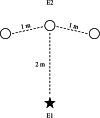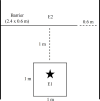A preliminary analysis of the effect of individual differences on cognitive performance in young companion dogs
- PMID: 38557907
- PMCID: PMC10984887
- DOI: 10.1007/s10071-024-01868-4
A preliminary analysis of the effect of individual differences on cognitive performance in young companion dogs
Abstract
Many factors influence cognitive performance in dogs, including breed, temperament, rearing history, and training. Studies in working dog populations have demonstrated age-related improvements in cognitive task performance across the first years of development. However, the effect of certain factors, such as age, sex, and temperament, on cognitive performance in puppies has yet to be evaluated in a more diverse population of companion dogs. In this study, companion dogs under 12 months of age were tested once on two tasks purported to measure aspects of executive function: the delayed-search task (DST) and the detour reversal task (DRT). Owners also filled out the Canine Behavioral Assessment and Research Questionnaire (C-BARQ) to evaluate how temperament influenced task performance. Contrary to prior research, performance did not improve with age on either task. However, the lack of age effects was likely the result of small sample sizes and individual differences across other factors influencing performance. Specifically, temperament differences as measured by the C-BARQ subscales for nonsocial fear and excitability predicted task performance on the DST, but the effect of temperament on task performance differed between males and females. Excitability also predicted performance on the DRT, but the effect depended on the age of the dog. In addition, no correlations were observed between task measures, indicating a lack of construct validity. Overall, these findings provide a preliminary analysis of factors that appear to influence cognitive task performance in young companion dogs and highlight suggestions for future research evaluating the impact of individual differences on cognitive performance.
Keywords: Cognition; Development; Executive function; Individual differences; Puppies.
© 2024. The Author(s).
Conflict of interest statement
The authors declare no competing interests.
Figures






Similar articles
-
Basal plasma oxytocin & fecal cortisol concentrations are highly heritable and associated with individual differences in behavior & cognition in dog puppies.Horm Behav. 2024 Sep;165:105612. doi: 10.1016/j.yhbeh.2024.105612. Epub 2024 Aug 7. Horm Behav. 2024. PMID: 39116461
-
Validation of the shortened version of the Canine Behavioral Assessment and Research Questionnaire (C-BARQ) using participants from the Dog Aging Project.PLoS One. 2024 Apr 11;19(4):e0299973. doi: 10.1371/journal.pone.0299973. eCollection 2024. PLoS One. 2024. PMID: 38603705 Free PMC article.
-
Development of a modified C-BARQ for evaluating behavior in working dogs.Front Vet Sci. 2024 Jun 28;11:1371630. doi: 10.3389/fvets.2024.1371630. eCollection 2024. Front Vet Sci. 2024. PMID: 39005721 Free PMC article.
-
Testing cognition in the wild: factors affecting performance and individual consistency in two measures of avian cognition.Behav Processes. 2017 Jan;134:31-36. doi: 10.1016/j.beproc.2016.06.004. Epub 2016 Jun 8. Behav Processes. 2017. PMID: 27288883 Review.
-
Individual variation in cognitive performance: developmental and evolutionary perspectives.Philos Trans R Soc Lond B Biol Sci. 2012 Oct 5;367(1603):2773-83. doi: 10.1098/rstb.2012.0214. Philos Trans R Soc Lond B Biol Sci. 2012. PMID: 22927576 Free PMC article. Review.
Cited by
-
Longitudinal evidence for the emergence of multiple intelligences in assistance dog puppies.bioRxiv [Preprint]. 2024 Sep 26:2024.09.26.615218. doi: 10.1101/2024.09.26.615218. bioRxiv. 2024. PMID: 39386489 Free PMC article. Preprint.
-
Exploring breed differences in discrimination, reversal learning, and resistance to extinction in the domestic dog (Canis familiaris).Sci Rep. 2024 Oct 15;14(1):24143. doi: 10.1038/s41598-024-76283-3. Sci Rep. 2024. PMID: 39407031 Free PMC article.
References
-
- Adams B, Chan A, Callahan H, Milgram NW (2000) The canine as a model of human cognitive aging: recent developments. Prog Neuropsychopharmacol Biol Psychiatry 24(5):675–692. 10.1016/S0278-5846(00)00101-9 - PubMed
-
- Arden R, Bensky MK, Adams MJ (2016) A review of cognitive abilities in dogs, 1911 through 2016: more individual differences, please! Curr Dir Psychol Sci 25(5):307–312. 10.1177/0963721416667718
-
- Barrera G, Alterisio A, Scandurra A, Bentosela M, D’Aniello B (2019) Training improves inhibitory control in water rescue dogs. Anim Cogn 22(1):127–131. 10.1007/s10071-018-1224-9 - PubMed
MeSH terms
LinkOut - more resources
Full Text Sources
Miscellaneous

